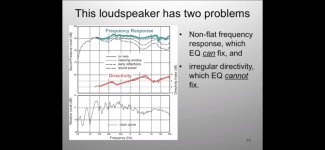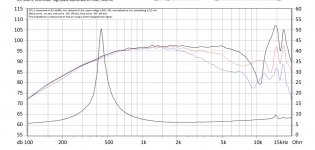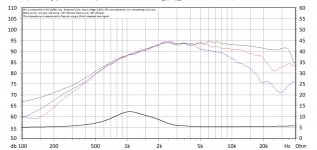Member
Joined 2003
If I'm going to use it as wide range midrange, I'd want to push it up to 4KHz or above. I mean, if you're crossing around 2Khz, a good 5" mid-range can do the job.
Here's the 60 degrees off axis response, compared to on-axis:
@3Khz- S: -5dB; P: -4dB; A: -4dB; B: -4.5 dB
@4Khz- S: -9dB; P: -6dB; A: -7dB; B: -11 dB
(Silk, Paper, Aluminum, Beryllium)
So time for planning that 200-400L dual 15-18” 3-way.
What to use on the bottom end that can crossover around 400Hz and have 95dB/2.83V after baffle step compensation… Eminence NSW4018-8?
Most small tweeter can do 4KHz and above including 3/4" dome and ribbons, so many options there...
Here's the 60 degrees off axis response, compared to on-axis:
@3Khz- S: -5dB; P: -4dB; A: -4dB; B: -4.5 dB
@4Khz- S: -9dB; P: -6dB; A: -7dB; B: -11 dB
(Silk, Paper, Aluminum, Beryllium)
So time for planning that 200-400L dual 15-18” 3-way.
What to use on the bottom end that can crossover around 400Hz and have 95dB/2.83V after baffle step compensation… Eminence NSW4018-8?
Most small tweeter can do 4KHz and above including 3/4" dome and ribbons, so many options there...
Last edited:
If I'm going to use it as wide range midrange, I'd want to push it up to 4KHz or above. I mean, if you're crossing around 2Khz, a good 5" mid-range can do the job.
Here's the 60 degrees off axis response, compared to on-axis:
@3Khz- S: -5dB; P: -4dB; A: -4dB; B: -4.5 dB
@4Khz- S: -9dB; P: -6dB; A: -7dB; B: -11 dB
(Silk, Paper, Aluminum, Beryllium)
So time for planning that 200-400L dual 15-18” 3-way.
What to use on the bottom end that can crossover around 400Hz and have 95dB/2.83V after baffle step compensation… Eminence NSW4018-8?
Most small tweeter can do 4KHz and above including 3/4" dome and ribbons, so many options there...
Pardon my newbie qn - why are you looking at 60 degrees off axis - 30 degrees off axis with toe in is still insufficient for your requirements?
Short version: Directivity mismatch.
Best 1.5 hours you’ll spend learning about speakers for domestic use:
Floyd Toole - Sound reproduction ? art and science/opinions and facts - YouTube
Best 1.5 hours you’ll spend learning about speakers for domestic use:
Floyd Toole - Sound reproduction ? art and science/opinions and facts - YouTube
Attachments
Short version: Directivity mismatch.
Best 1.5 hours you’ll spend learning about speakers for domestic use:
Floyd Toole - Sound reproduction ? art and science/opinions and facts - YouTube
If this is the requirement, then are we shoehorned into 10F or some horn for the midrange section or crossing it lower?
I want to try the T25A and M74P combo in my 4-way loudspeaker and later upgrade to the Be range.It's Lord of the rings- One(4) dome midrange to rule them all
Golum wants
If this is the requirement, then are we shoehorned into 10F or some horn for the midrange section or crossing it lower?
I don't think it's a requirement, per se. I mean, it's already better than the Volt 752 in terms of dispersion, which is down about 9dB at 3Khz. So for the Bliesma, I'd start looking at a LP at around 3Khz.. and see if I could take a bit higher.
Meanwhile I'd try to balance out getting a smooth phase transition at the crossover point.
30 degrees is a good point to start looking at where to cross.
I just prefer to go wide as possible without compromising too much on the factors, including power handing of the tweeter and distortion at the target SPL.
Have you seen Philharmonic Audio's latest speaker? It's dispersion is crazy wide out to even 90 degrees:
I mean, can one tell where the crossover points are?

Last edited:
I don't think it's a requirement, per se. I mean, it's already better than the Volt 752 in terms of dispersion, which is down about 9dB at 3Khz. So for the Bliesma, I'd start looking at a LP at around 3Khz.. and see if I could take a bit higher.
Meanwhile I'd try to balance out getting a smooth phase transition at the crossover point.
30 degrees is a good point to start looking at where to cross.
I just prefer to go wide as possible without compromising too much on the factors, including power handing of the tweeter and distortion at the target SPL.
Have you seen Philharmonic Audio's latest speaker? It's dispersion is crazy wide out to even 90 degrees:
I mean, can one tell where the crossover points are?
That is not a fair comparison. The Blisema is larger than the BMR. The BMR with the Raal ribbon probably have a different sound signature to Beryllium. There is no rule saying you can't have more than 1 speaker in your home.
I'm not talking about the BMR as a comparison. I'm talking about overall speaker design. Sorry to go off tangent.
I'm talking about 3" dome midranges and how far to take the Bliesma 3" domes, and approximately where to implement a LP filter. If one were to crossover around 2KHz, I think it would be a waste, because 4" and 5" cones can already do that. In my mind, the advantage of a 3" dome is, (apart from the higher sensitivity) is the ability to cross higher, without compromising on the directivity, or dispersion, as the crossover point.
I think somewhere between 2-4Khz would be the sweet spot, but exactly depends on your design goals and other factors eg. tweeter, baffle...
I think it's already better than the VM752, as far as dispersion is concerned.
And price too (1/3 less)
I'd like to see some independent measurements from Hifi Compass or Voice Coil, particularly regarding the low end, because it will help me select the largest woofer that plays nicely with the HP of the Bliesma dome.
I'm talking about 3" dome midranges and how far to take the Bliesma 3" domes, and approximately where to implement a LP filter. If one were to crossover around 2KHz, I think it would be a waste, because 4" and 5" cones can already do that. In my mind, the advantage of a 3" dome is, (apart from the higher sensitivity) is the ability to cross higher, without compromising on the directivity, or dispersion, as the crossover point.
I think somewhere between 2-4Khz would be the sweet spot, but exactly depends on your design goals and other factors eg. tweeter, baffle...
I think it's already better than the VM752, as far as dispersion is concerned.
And price too (1/3 less)
I'd like to see some independent measurements from Hifi Compass or Voice Coil, particularly regarding the low end, because it will help me select the largest woofer that plays nicely with the HP of the Bliesma dome.
Last edited:
Here's the 60 degrees off axis response, compared to on-axis:
@3Khz- S: -5dB; P: -4dB; A: -4dB; B: -4.5 dB
@4Khz- S: -9dB; P: -6dB; A: -7dB; B: -11 dB
B looks more like -8.5dB @ 4k 60deg to me. I ordered the M74B to pair with T25B but have to say I was tempted by the M74A. Can't go wrong with any of them by the looks of it.
Last edited:
Member
Joined 2003
Without accurate indication of SPL (or at least applied RMS voltage), distance, mic used, etc. you can effectively throw your measurement out for any direct comparison. The greatest benefit from Hificomapss measurement set is that you have a rather large list of drivers measured under equal conditions that can be directly compared.
You're also measuring a different Md60 which may point to some QC concerns if you do in fact have significant difference in measured result, which should be more of a red flag to avoid the driver than anything, but those conclusions can't be made based on the data as presented.
What we can conclude, is that the frequency response and impedance of the Md60 that Hificompass measured is rather different than the datasheet from 500-1500Hz, so it's very possible that he got a "bad" driver. IMO, this driver is more likely to have consistency issues with the specially tuned resonant chamber, it will require consistent qty and installation of damping material in production.
You're also measuring a different Md60 which may point to some QC concerns if you do in fact have significant difference in measured result, which should be more of a red flag to avoid the driver than anything, but those conclusions can't be made based on the data as presented.
What we can conclude, is that the frequency response and impedance of the Md60 that Hificompass measured is rather different than the datasheet from 500-1500Hz, so it's very possible that he got a "bad" driver. IMO, this driver is more likely to have consistency issues with the specially tuned resonant chamber, it will require consistent qty and installation of damping material in production.
Last edited:
What equipment have you used? As stated earlier without knowing that talking absolute values as well as comparing is not very meaningful. The owner of hificompass went through a lot of steps to get his system to produce meaningful and reliable measurements. It’s not “get Omni mic and press measure thd button” process.
The voltage doesn't say much at all.
I agree with DcibeL, drivers should be referenced to the same SPL levels.
Otherwise it's kind of apples vs pears.
That being said, the measurements of Hificompass correlate quite well with Hobby Hifi for example.
Second, absolute levels are never that interesting to be very honest.
I am more interesting how to behave on a relative way.
And like DcibeL says, you can still compare them within the same set.
The little feedback that I have (for almost everyone who is doing measurements) is that they don't (all) use the same graphs. Hificompass also uses highpass filters sometimes.
Which is only mentioned when you look closely at the description of the graphs.
Also 2.83V is already pretty high, especially for smaller speakers as well of seeing any correlation between the given T/S parameters and how they behave.
I would really like to see an additional step on a low level pink noise or similar.
I agree with DcibeL, drivers should be referenced to the same SPL levels.
Otherwise it's kind of apples vs pears.
That being said, the measurements of Hificompass correlate quite well with Hobby Hifi for example.
Second, absolute levels are never that interesting to be very honest.
I am more interesting how to behave on a relative way.
And like DcibeL says, you can still compare them within the same set.
The little feedback that I have (for almost everyone who is doing measurements) is that they don't (all) use the same graphs. Hificompass also uses highpass filters sometimes.
Which is only mentioned when you look closely at the description of the graphs.
Also 2.83V is already pretty high, especially for smaller speakers as well of seeing any correlation between the given T/S parameters and how they behave.
I would really like to see an additional step on a low level pink noise or similar.
I think the summed response will be fine. And the advantages would be:
-1 driver playing the most critical range
- Higher SPL capabilities, and lower distortion from the tweeter
- No crossover point in the most critical range
I’ve built 2 ways with ribbon tweeters and 5.25” cone drivers crossed over at 4.5k and the soundstage was stunning. And the sound was very homogeneous due to a single driver playing the critical frequencies. And these domes have far better dispersion than those 5.25” cones.
-1 driver playing the most critical range
- Higher SPL capabilities, and lower distortion from the tweeter
- No crossover point in the most critical range
I’ve built 2 ways with ribbon tweeters and 5.25” cone drivers crossed over at 4.5k and the soundstage was stunning. And the sound was very homogeneous due to a single driver playing the critical frequencies. And these domes have far better dispersion than those 5.25” cones.
- Home
- Loudspeakers
- Multi-Way
- Some speaker driver measurements...



